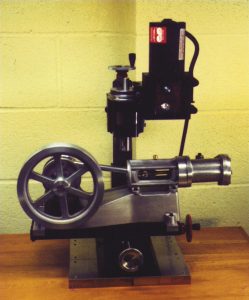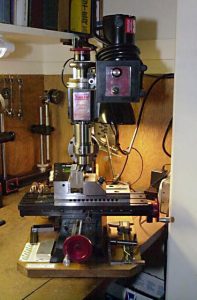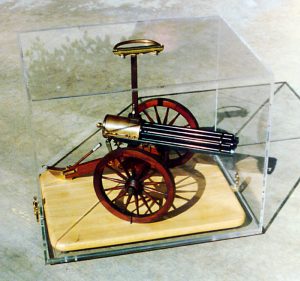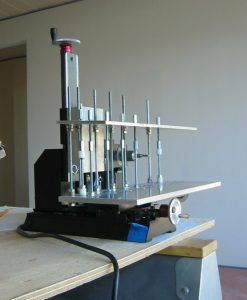Welcome to the Sherline Workshop
This section will feature some of the work done by modelers and machinists using Sherline miniature machine tools. It will serve two purposes. First, it will give us a chance to show off some of the fine work being done on tabletop-sized machine tools. Second, it allows us to give credit to those who are doing that work. We have also included some projects that were not necessarily built on Sherline tools but offer ways to make your Sherline workshop more efficient and fun.
If you have a project of your own you would like to see included here, please email digital photos and an explanation to marketing@sherline.com.
General Projects
Click on the above link to jump to the General Projects section
Features projects of general interest, from toy trains to stamping dies.
Compact Workshops
Click on the above link to jump to the Compact Workshops section
It doesn’t take a lot of space to set up a very complete and productive shop with Sherline tools. Visit some shops that show what can be done in a compact area.
Gunsmithing Projects
Click on the above link to jump to the Gunsmithing Projects section
Making, repairing, and restoring guns is a highly demanding and specialized part of the world of machining, and many parts and operations are sized appropriately for Sherline tools. This page features only gun-related machining projects for you would-be home gunsmiths.
Extreme Machining Projects
Click on the above link to jump to the Extreme Projects section
A separate section has been added showing setups for projects that are really too big to be made on Sherline tools, but determined craftsmen did them anyway. Check it out.
A list of general project links:
- Steam Engine Projects—Alvin Warren
- Woodturning Project—Dave Hosom
- Child’s Toy Train Project—Keith Yundt
- Black Powder Cannon—Robert Shipley
- Clock Case Projects—Robert Shipley
- Miniature Stamping Die—Frank Warrick
- Texas Christian University Machine Shop
- Aluminum Corsair Model—Young Park
- Making Steering Wheels for Model Cars—Marvin Meit
- Machines as Works of Art—William Dubin
- Dime-Sized 14-Cylinder Radial Aircraft Engine Model—Augie Hiscano
- Miniature Grandfather Clock—Frank Brad
- Tiny Turbine Engine Project—Andy Paul
- Detailed RC Ship Models—Andrew Green
- Model Hotrod Shop and Car Models—DL
- Award-Winning Model Cars—Mark Jones
- A Lathe with Permanent Riser Blocks Set up for Threading—Jim Knighton
- Gold Plated Auto Presentation Models—Michael Dunlap
- Case Tractor Project—Alvin Jeske
- Jewelry: Titanium and Stone Rings—Mark Stone
- Award-Winning Model Cars—Dirk Joseph
- Monster RC Truck Axle—Michael Gegere
- Cab Forward Live Steam Locomotive—Dwight Ennis
- Watch Case and Crown—Marc-André Lemieux
- Animated Clocks and other Mechanical Works of Art—Thomas Kuntz
- Circuit Testing Machine—Stephen Nelson
- Fossilized Ivory Guitar Bridge Pins—Mike Fleck
- Music Box—Geoffrey Rhodes
- Sherline Table Saw Attachment—Carl Hammons
- Super-Detailing a Tamiya McLaren F1 Model—Tom Castermans
- Miniature Vintage Woodworking Tools—John Maki
- 1/2-Scale Running Briggs & Stratton “Y” Engine—George Baisz
- Elk Antler Watch Cases and Wooden Pens—Charles Grower
- Cutting a Tiny Watch Escape Wheel—Jerry Kieffer
- Sherline-Powered Scroll Saw—Jerry Glickstein
- Cutting Helical Gears on a Sherline Mill—Carlos Vicente
- Model Car Customizer—Alvis Barrington
- Steam Engine Miniatures—Chris Rueby
- Turning New Handwheel Dials—Paul Petrzelka
- 1/24 Scale Model V-2 Rocket—Tony Guyer
- Bantam Fuel Altered Model—Tim Hoagland
- 1:24 Scale Engine Modeled after the West Side Lumber Company’s Porter—Ede Biro
- Making a Crystal Wheel Skeleton Clock—Roger Adams
- Crankshaft Project—Dave Glemming
When people think of the word “machine shop,” they often think of a dark, dirty, oily shop filled with huge, noisy machines. Tabletop machine tools like those offered by Sherline take machining and woodworking into new territories—like your basement, den, kitchen, or even a closet! You don’t need a lot of space, and you don’t need to make a big mess. Because miniature machining projects, for the most part, don’t use the larger tools you might use to work on your car or do other construction jobs, they don’t have to be located in the same area. You can bring your machine tools indoors to work in the evening in heated or air-conditioned comfort. If you have an apartment or condominium, you don’t have to be left out of the fun of making fine, small projects. These machines make little more noise than a sewing machine, and their mess can be cleaned up with a small vacuum cleaner or mini shop vac.
Joe Martin notes that one of the keys to working efficiently in a small shop is to clean up after yourself often. Containing chips and vacuuming often will also help keep from tracking them into other parts of the house. Working small tends to force organization on you because you can only set so many tools down on your bench before you run out of space. Keeping your work surface free from clutter means having a designated place for everything and putting each tool or accessory in its place when you’re not using it. The good part about this is when you are done, almost everything is already put away!
Below are some shops put together by people with limited space but the desire to make things. Without much effort, you can probably imagine a shop like one of these in your house, no matter how pressed for space you are. If that is what has been holding you back from making the projects of your dreams, these shops might give you some ideas on how you can finally build the things you’ve wanted to do in spaces you may not have considered.
A list of compact workshop links:
- Shop in a Closet—Marvin Meit
- Traveling Workshop—Jerry Kieffer
- Compact Home Workshop—Ronald Melvin
- Portable Workshop in a Tool Box—R.W. Markgraf
- Kitchen Workshop—Steve Peirce
- Woodworking Shop—Chris Rueby
- A Traveling Shop in a 5th-Wheel Tow Vehicle—Lloyd Leech
- Garage Workshop—Joe Martin
- World’s “Messiest” Shop—Paul White
- Closet Shop with Big Capabilities—Phil Bee
- Boxed Lathe and Mill—C.B.
- Flying Sherline Workshop—Jason Chastain
- Lathe Stand—Nelson Giesecke
- Moveable CNC Benchtop Lathe Station—Robert Lawson
Read and understand all appropriate federal, state, and local firearms regulations and guidelines before making or modifying a firearm.
Restoring vintage firearms, adding better sights to existing weapons, building miniature replicas or working firearms, or scratch-building projects of your own are all possible on Sherline tools if the parts are sized appropriately. All projects shown here conform to federal firearms regulations. We have added this page because we get many inquiries from people considering small gunsmithing projects of their own. Shown below are some projects or modifications people have made using Sherline tools.
A list of gunsmithing project links:
- Rifle Scope Mount—Jerry Kieffer
- Gatling Gun on Carriage—Michael Gegere
- .25 Cal Gatling Gun—Michael Gegere
- .177 Cal Gatling Gun on Tripod—Michael Gegere
- 1/2-Size Model of 1896 6.5 mm Bergmann Pistol—Roger Ronnie
- 1/2-Size Model of a Rare 1910 10-Gauge Lefever Shotgun—Roger Ronnie
- A Fixture for Checking .22LR Match Rounds for Concentricity—Bill Young
By popular demand, we are including photos of projects that are really too big to be made on Sherline tools. If a potential customer were to ask if this operation could be done, we would say, “No, you need a bigger machine.” But modelers are among the most resourceful craftsmen in the world, and many find it a challenge to make things that everyone else said couldn’t be done. The people setting up these operations are experts with their tools and know-how to get more out of them than was ever intended and still get good results. This page is in no way intended as a recommendation for setups like this, but if you use small tools and occasionally run into a part that is a bit too large but needs to be done anyway, perhaps some of these setups will give you some ideas of how to accomplish the impossible.
For those who want to see a good movie that represents the attitude involved here, we recommend Flight of the Phoenix, starring James Stewart, Richard Attenborough, and Peter Finch. If ever a movie represents what can be done by a good modeler, that one is the best. The movie is about a cargo plane that crash lands in the Sahara desert. The only way out is to rebuild the wreck into a smaller plane that can fly them out using the one remaining good engine and the parts and tools at hand. The “engineer” who directs the process turns out to have only built model airplanes before, but his modifications work. To him, this is no different than a model airplane project using full-size parts. Even if you’ve already seen it, it’s worth watching again for inspiration.
Charlie Lear recently ran a little experiment to see how large a part he could turn using a mill instead of a lathe. Check out his very comprehensive web page at http://steammachine.com/millturn for the results.
A list of extreme machining project links:
- An Oak, Model Display Case—Jerry Kieffer
- Machining Large Steam Engine Castings—Pam Weiss
- Cutting 7″ and 14″ Diameter Gears on a Sherline Mill—Mark Jones
- A Portable Metal Door Jamb Router from a Sherline Mill—Gregg Roos



